When you have only a single page to make your job search case, it is well worth pausing for thought when you write your cover letter. You have an opportunity to connect with your future employer, but what do you want to say to them?
Done well, a cover letter can set you apart from the crowd and give you a competitive advantage by encouraging the hiring manager to read your CV and learn more about you.
So, how do you hit the right note? In this expert guide, we’ll explore how to write a cover letter, what you need to include in each section, and provide some adaptable examples to make this process a breeze.
What is a cover letter?
A cover letter is a brief, introductory message that is sent to a hiring manager to accompany your CV. A great cover letter will demonstrate your interest in the role, describe your positive impact in previous roles, and market you as the perfect person for the job.
Typically, cover letters are only three to four paragraphs long and around 300 to 400 words. For this reason, you need to be selective about the information you include. The overall goal is to be concise, persuasive, and ensure your cover letter is relevant to the specific job opening.
Before we get started on how to write a cover letter, check out our cover letter example for some inspiration:
Pick a cover letter template
Every aspect of your cover letter contributes to your chances of landing an interview. The cover letter template you select can help you set the right tone and ensure you stand out to recruiters.
At Resume.io, we have a wide range of simple, creative, modern, and professional templates that you can easily edit to your requirements.
Simple
Balancing attractive and functional design to perfection, our simple CV templates present your cover letter in a clear and crisp format. This template can easily be used across a wide range of professions and industries.
Creative
Allow your personality and passion to shine through in your cover letter with our creative templates. Creative flourishes and plenty of colour will convey your unique perspective.
Modern
Looking to be ahead of the curve with your cover letter? Our modern CV templates offer a fresh approach and stylish design, giving you the edge as a job seeker targeting innovative industries.
Professional
Exude your professionalism and experience level to land your next big position. Our field-tested templates are trusted by thousands of professionals just like you.
Choose our Microsoft Word or Google Docs cover letter templates for quick and easy editing.
Cover letter structure (what to include)
While every cover letter is different, they all have the same structure. Each section plays an integral role in the development of a compelling and professional cover letter.
Here are the key elements you need to consider when writing a cover letter for a job application:
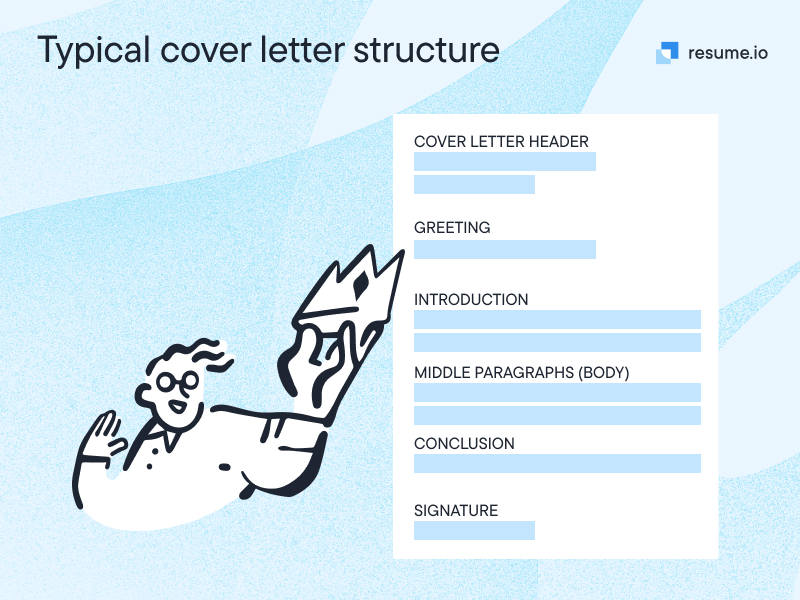
- Cover letter header. Project your professionalism with a clear and crisp CV header, including your full name, phone number, and LinkedIn handle.
- Greeting. Begin your cover letter by addressing the hiring manager directly by their name for a more personalised approach. Another option is to use the team or department name.
- Introduction. Hook the reader with an impactful introduction to your cover letter that encourages them to read on and learn more about you.
- Middle paragraphs (body). Across two to three paragraphs, showcase your skills, abilities, and accomplishments. Add a twist of personality to build rapport with the reader.
- Conclusion. End your letter by reinforcing your suitability and interest in the job opening. Don’t forget a polite call to action to nudge the hiring manager to get in touch with you.
- Signature. Wrap up with a professional sign-off, such as “Sincerely” or “Best regards” and your full name.
Conduct some background research
Always research the company, role, and hiring manager before you start to write your cover letter. Use your findings as a guide to the content you create in the main body section of your letter. Tailoring your cover letter to the specific job opening will tell the hiring manager that you do really want to work there!
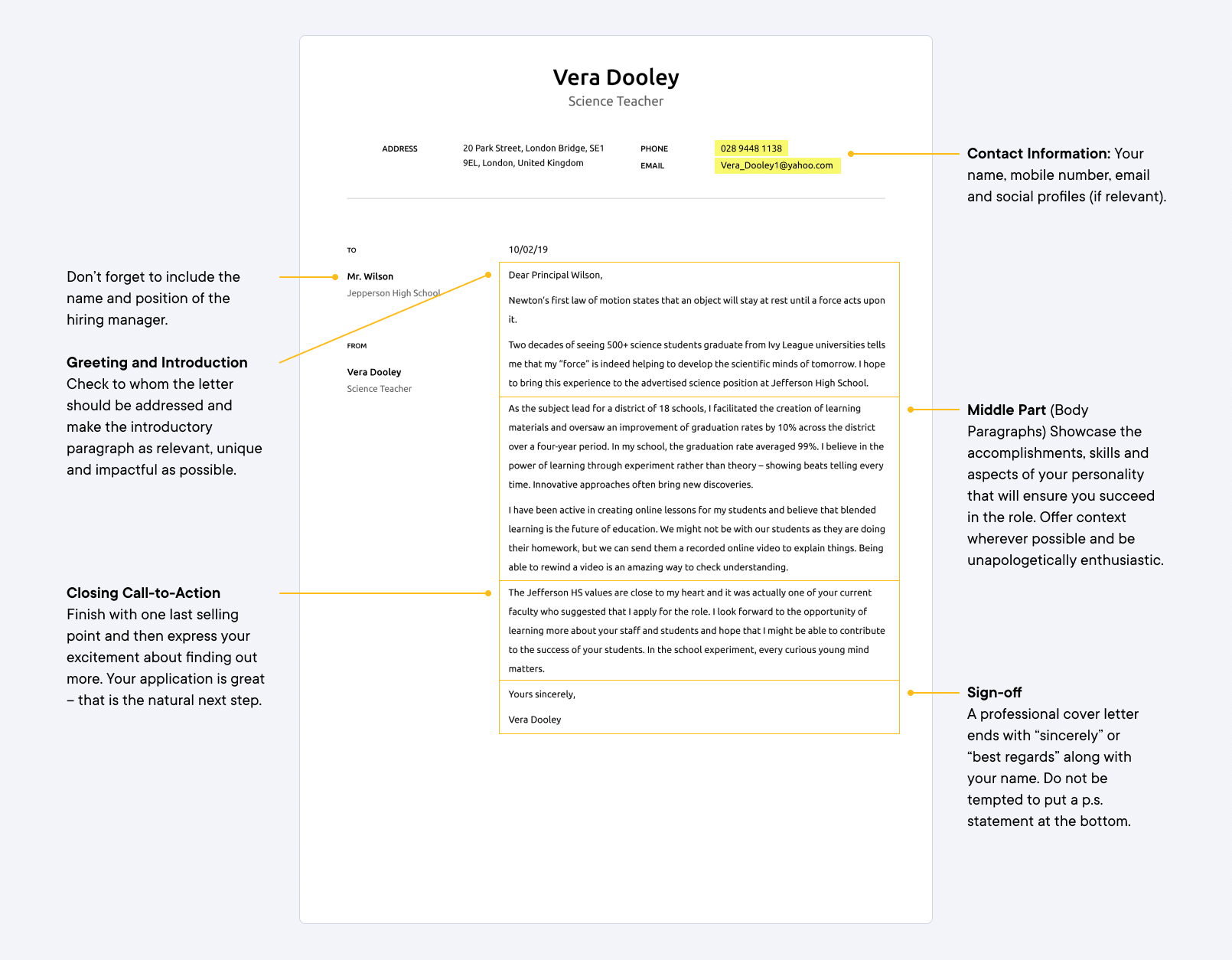
Step #1: The cover letter header
Once you've selected your ideal cover letter template, the next step is to get started on the actual content. Here’s how the cover letter header section should look:

The cover letter header section is the most functional, but also the most essential. After all, it gives the hiring manager the contact details they need to invite you to an interview.
Your header should include your full name, the title of the job you are targeting, your location (no need to include your full address), your professional email address, and your phone number. Most employers will check your LinkedIn, so it’s worth polishing your profile and adding a link.
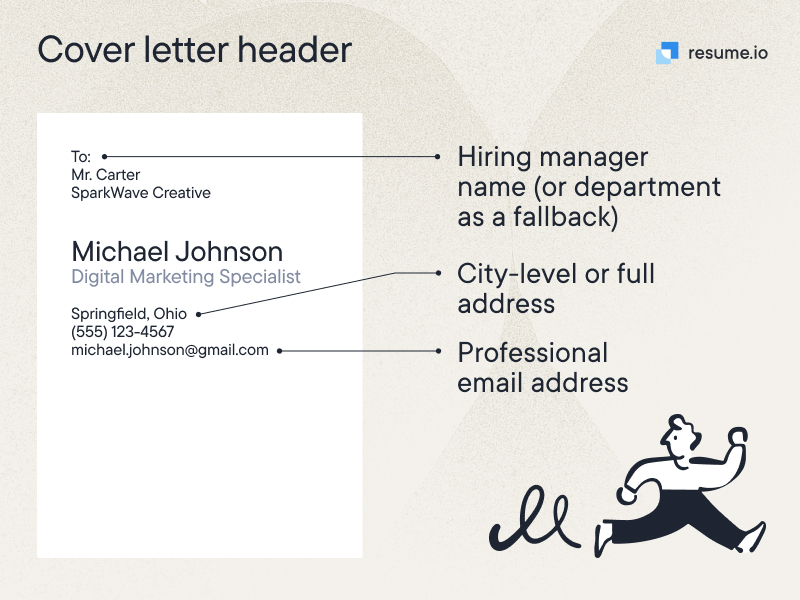
You also need to add the details of the company that you are applying to, including the hiring manager’s name. Here’s an example of how this information might look:
[Your Full Name]
[Target Job Title]
[Location] | [Phone Number] | [Email Address] | [LinkedIn URL (optional)]
[Hiring Manager’s Name]
[Company Name]
[Address]
[Date]
Try our user-friendly cover letter builder to get started. Simply enter the information detailed above in each field. Then the tool will create your unique header in a matter of seconds.

Step #2: The greeting/salutation
Begin your cover letter by greeting the hiring manager directly. This is a more personalised approach and your first chance to build rapport. If the hiring manager’s name is not on the job advert, online research or a quick phone call to the company should uncover this information.
Most cover letters should start by using “Dear” and the hiring manager’s title and surname. Try to avoid any casual greetings, such as “Hi” as well as using first names. Check our examples below to see how to do this the right way:
Dear Mr. Andrews
Hi Simon
Struggling to find out who the hiring manager is? In that case, it’s fine to use the team or department name instead. For example, “Dear finance department,” or “Dear marketing team.”
Whatever you do, avoid the “To Whom It May Concern” variant. You might think that it sounds professional, but it’s now seen as being cold and quite outdated. Not a look you would want to convey to the hiring manager as they start to read your cover letter.
Mirror company tone in your cover letter
When making the ultimate decision of hiring a new employee, employers are looking for suitably qualified candidates, but also applicants who will be a good fit for company culture.
Mirror the language and tone of any corporate writing that you can find. This will send a strong indication that you are aligned with the company and will integrate easily into the team.
When your application is being compared to a similarly qualified candidate, these minor adjustments can make all the difference.
Step #3: The cover letter intro
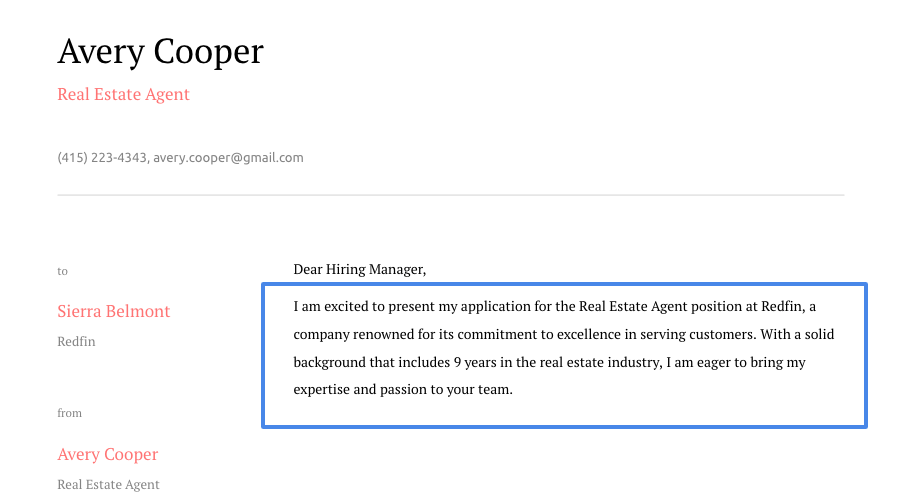
A cover letter’s opening paragraph needs to pack some punch and “hook” the reader so they are keen to read on. Recruiters receive a high volume of applications, so it’s crucial to capture their attention at the start of a cover letter to stand out.
The most common problem with opening paragraphs is that they can be very generic, so once a recruiter has read one or two they will all blend into one and become instantly forgettable. An interesting anecdote, notable accomplishment, or impressive statistic relevant to the advertised role will be more impactful and prevent you from falling into the generic pile.
The strategy you choose will depend on your career history and level of experience. Here’s a selection of copyable examples to give you some inspiration:
Example 1: Include an achievement
Having contributed to the design and manufacture of 20+ medical devices and recently securing nomination for the Medovate Best Medical Innovation award, I am confident of my ability to succeed in the advertised Design Engineer role with DEF Healthcare.
Example 2: Start with an anecdote
Many people tell me that working in technical support for one of the Big 3 is all the same, but after speaking to industry professionals and attending your recent Power Platform event on AI business innovation, Microsoft really stands out to me.
Example 3: Provide a personal touch
After hearing about the upcoming launch of the ABC Skincare product line, I’m excited to apply for the role of Marketing Associate. I believe my skills in storytelling and product orientation will greatly benefit your team. I’m a huge supporter of your brand, and I’d love to bring my creative outlook to contribute to ABC Beauty’s future goals.
Example 4: State your goals
As a recent journalism graduate with experience working in professional media via a one-year internship, it’s my goal to be part of an award-winning team that delivers prompt, accurate, and engaging business news. As an avid audience member of Telegraph Media Group, I feel confident in my ability to engage with your readers across multiple platforms.
Step #4: The middle paragraphs (body of the letter)
Once your intro has worked its magic and captured the interest of the hiring manager, you now need to address the all-important middle (body) section of your cover letter. In this section, you need to elaborate more on your experience, key skills, and achievements - especially those that relate to the job advertisement.
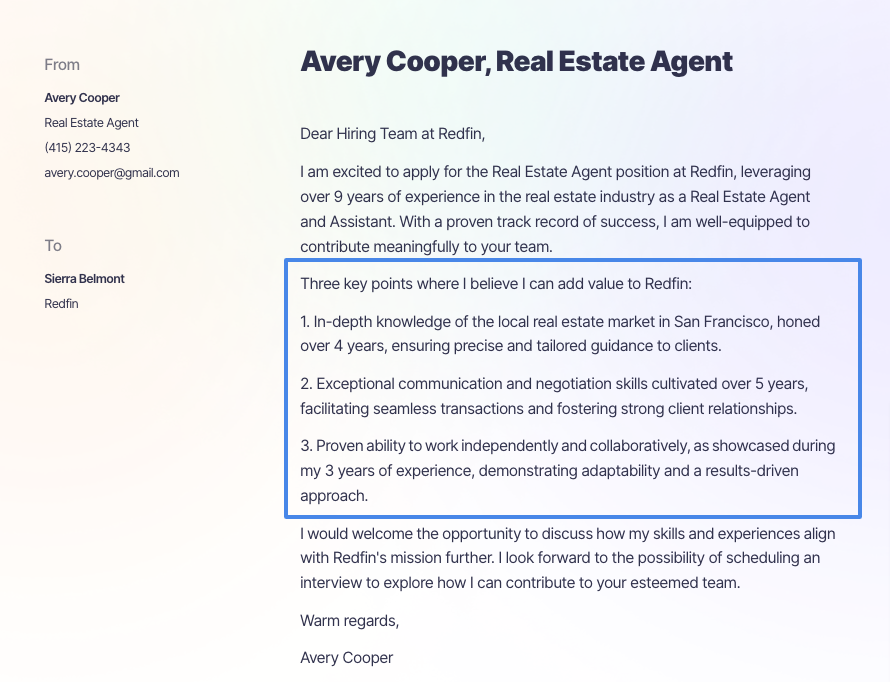
There are many different elements you can choose to focus on in the main body of your cover letter to explain why you’re the right person for the job and the value you will bring.
Let’s take a look at these key areas.
- Skills and experience. Paint a picture of your relevant skills and experience in action by referencing specific situations in the workplace and positive outcomes.
- Industry expertise. Do you have any specialist knowledge in your chosen industry? How do you stay updated on new and emerging trends? Holding specialist expertise and staying ahead of the curve in your sector is extremely attractive to prospective employers.
- Education. Explain how your education has benefited your career to date, including a reference to your highest and most impressive qualifications that relate to the job posting.
- Company alignment. Companies are looking for individuals who are passionate about joining their company. Your cover letter offers the perfect opportunity to show how you align.
- Goals and aspirations. What are your future career goals and aspirations? How does this relate to the employer and their short- and long-term objectives?
- Additional experience. Have you secured any experience outside of the workplace that has prepared you for the job opening? If so, add those details here.
Cherry pick the most appropriate elements from this list to include in your main body section. You don’t need to include every area as this will make your cover letter too long and less impactful as a result. Here’s a copyable example to give you some inspiration:
Currently in the final year of my degree in Chemical Engineering, I’ve acquired a strong understanding of engineering design principles and process design, with emphasis on natural resources engineering. I have achieved excellent results, including a predicted 2:1, and have confirmed my passion for developing a career in environmental engineering.
I recently completed an internship with BA, which provided me with valuable transferable skills in project management, communication, data analysis, and technical reporting. I was commended on my performance in project teams and secured an excellent work reference.
Following graduation, I would love to work for a forward-thinking organisation like ABC Engineering, where I can increase my experience, deliver optimal client support, and grow with the company. I believe that choosing the right opportunities, working with reputable clients, and focusing on my professional development will enable me to achieve these goals.
Step #5: The final paragraph of your cover letter (conclusion and call-to-action)
Delivering a strong finish to your cover letter is just as important as a positive start. So, how can you conclude your letter on the right note? By emphasising your suitability for the company as well as reinforcing that offering you a position would be the best option.
- Connect your talents to the role. Summarise how you plan to apply your skills and past experiences to achieve company goals and exceed expectations.
- Highlight your value. Reference where you align with the company vision and values to demonstrate that you’ll be a perfect fit for the team.
- Clarify points of explanation. For example, if you’re relocating to the location where the job opening is based, mention this in your conclusion. This will alleviate any concerns the hiring manager may have as to why you currently live in a different area.
Wrap up your final paragraph by thanking the employer for their time and consideration in reviewing your CV. You should also include a call-to-action to encourage the hiring manager to follow up with you. Here’s an example:
Thank you for taking the time to review my application. I look forward to learning more about the retail position and Shop&Go. I am focused on delivering an optimal customer experience and excited about the possibility of joining the market-leading team at Shop&Go.
Step #6: The sign-off

Finalise your cover letter with a professional sign-off, such as “Kind regards” or “Sincerely,” followed by your first and last name. Signing your cover letter in this way will sound more professional, rather than using casual terms, such as “Thanks.”
Kind regards,
Ava Peters
Thanks,
Ava
How to make a cover letter with no experience
Creating a cover letter with no experience can feel like a challenging task, but everyone has to start somewhere. With the right approach, you can get a foot in the door. The key is to reassure the hiring manager that your lack of experience won’t be an issue.
Whether you’re a recent graduate or a career-changer, here are some strategies to help you tackle the obstacle of writing a cover letter when you have zero experience:
- Enthusiasm for the industry. Show your excitement for the new opportunity and the industry in which the company operates. What compelled you to apply for the job? Why are you interested in this specific industry? What are your future career plans?
- Showcase transferable skills. Check the job posting for desired skills and abilities. This should include both hard skills (technology and industry-specific skills) and soft skills (communication, collaboration, and organisation skills for example).
- Highlight relevant qualifications. Emphasise relevant skills and competencies that you have acquired from school projects, courses, extracurricular activities, and community or personal projects. For example, if you’re applying for a digital marketing role, you could highlight how you revamped the college website with engaging blogs on student life.
- Spotlight related work experience. Mention any volunteer work, freelance gigs, or part-time jobs that have provided practical experience in your target career. Even if this experience is not directly related to the job advertised, there may still be some crossover. For example, if you volunteered at a summer club for kids and are applying to be a teacher assistant, then you can highlight your experience working with children.
Don’t let a lack of experience put you off applying for a job that you are extremely passionate about. Invest time to write a tailored cover letter that showcases your talents and skills.
Use AI or ChatGPT to write your cover letter
When you’re conducting a job search it can get pretty overwhelming as you juggle creating application documents, including unique cover letters for every job opportunity. Leveraging tools like AI and ChatGPT can help you get ahead in the application process and reduce stress.
But, when you’re creating your cover letter via ChatGPT, using the right prompts is vital. If you blindly trust ChatGPT you’re likely to generate a formulaic letter that a recruiter may pass over or recognise as purely AI-generated. The best approach is to balance AI with a human touch.
Here are some of the ways you can harness AI to your best advantage
Tailor your cover letter to the job description
A strong cover letter is specifically designed to align with the requirements outlined in the job description. Our cover letter builder includes an advanced AI feature that helps you create an impressive cover letter, increasing your chances of landing that interview. Start by drafting your cover letter content, and then let the tool enhance it in just seconds.
- Create or upload your CV: You can either build a new CV or upload an existing one within the builder.
- Share the job description: Provide the job description by copying and pasting the text or sharing the URL.
- Generate your cover letter: Click “Generate” in the CV section. This will create a customised cover letter that includes references and keywords from the job description.
View our example below to see how this works:
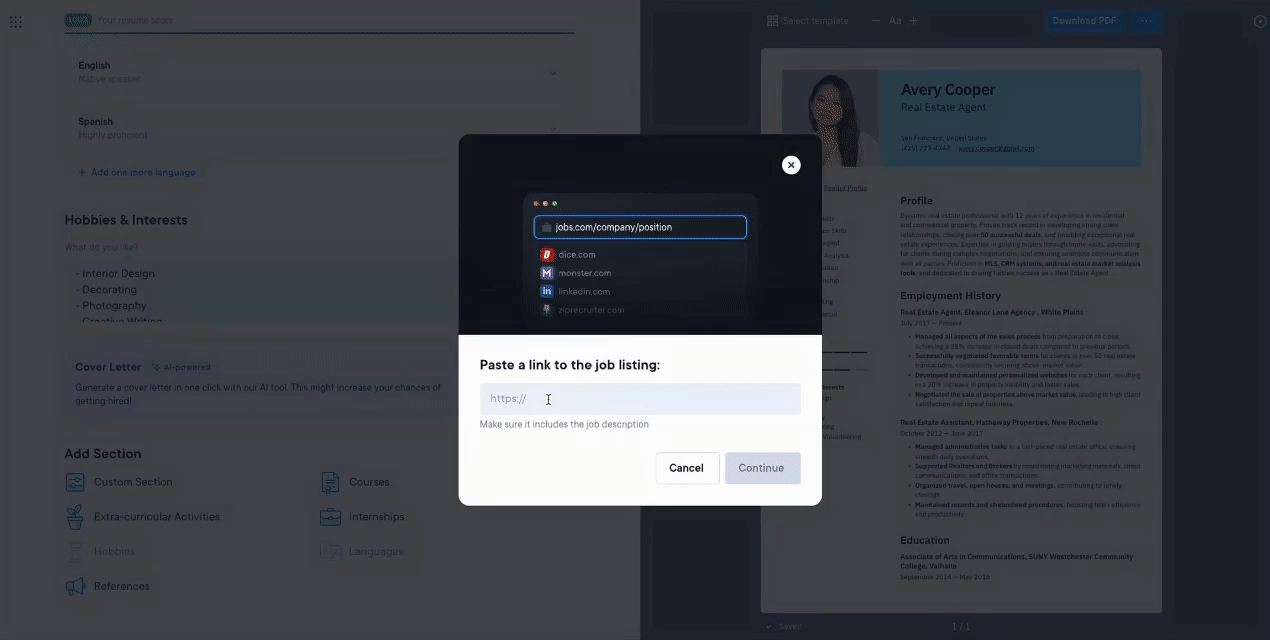
Make sure to fully review and proofread the cover letter after using this feature. Adjust the AI-generated content to ensure it’s completely accurate and reflects your experience.
Use ChatGPT to outline your cover letter
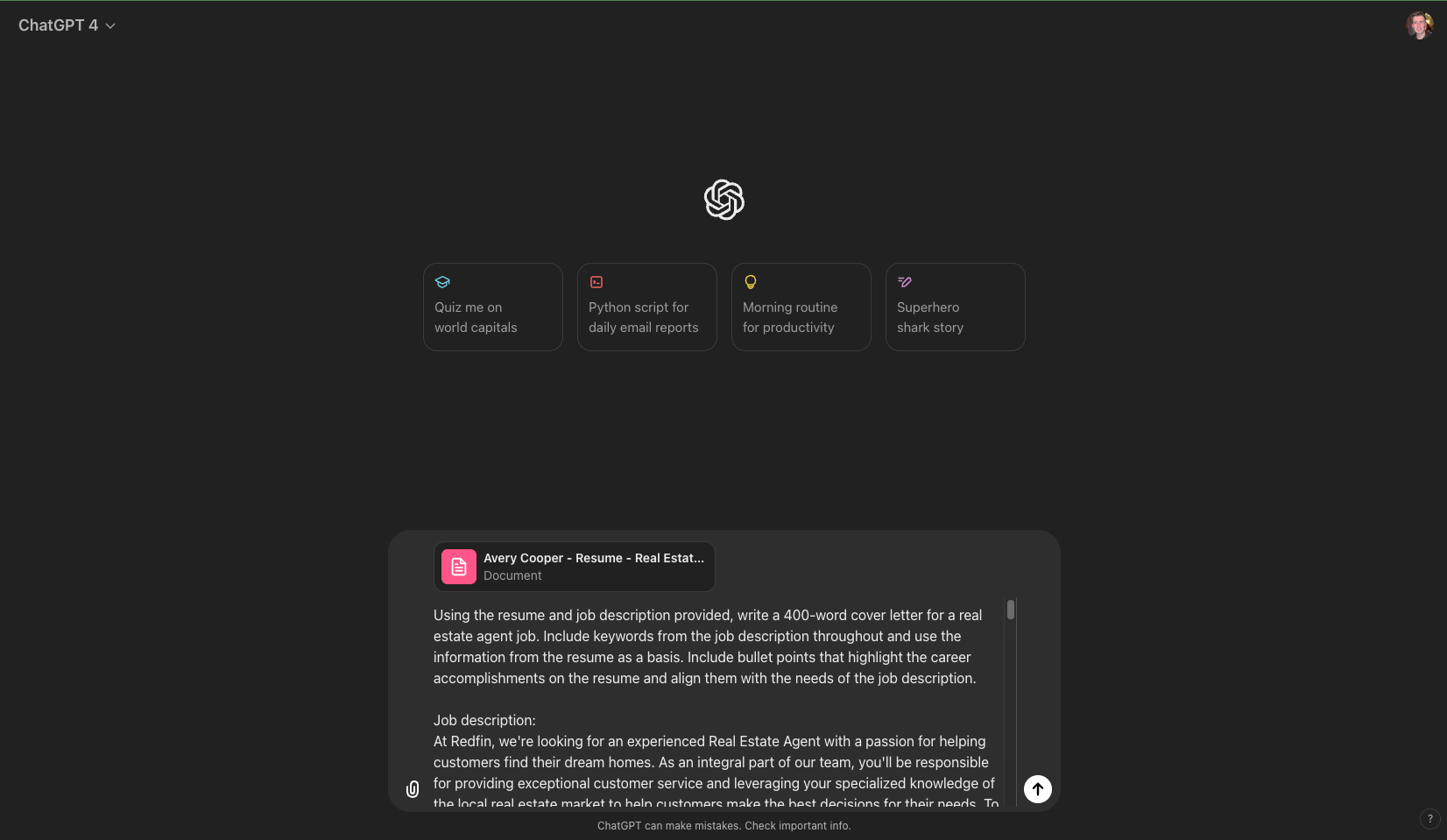
Although our cover letter generator aims to deliver the most comprehensive output, you can also use ChatGPT to help you kick things off.
To begin, you'll need to provide some information. Upload your CV along with the job description for the position. Then, prompt the AI tool to create an outline for your cover letter.
Try this prompt: “Hi ChatGPT, Can you write a cover letter? I’m currently a digital marketing assistant and I am applying for a job as digital marketing associate at ABC Marketing. Can you make the cover letter four paragraphs long and around 280 words. Can you bullet point three notable achievements in the second paragraph with a line that introduces the achievements.”
Here is the job description: [Copy and paste the core responsibilities for the job opening]
Here is my CV: [Copy and paste relevant experience from your CV]
Provide as much specific detail as you can in your prompt to ensure the delivery of a well-written cover letter. However, you still need to proofread and tweak your cover letter to check that it is factually correct and also sounds authentic.
Optimise your cover letter for the ATS software
Applicant Tracking Systems (ATS) are used by many employers to scan incoming job applications for keywords – usually matching the job description – and rank them by keyword inclusion. If you use the right keywords, your application will be reviewed by human hiring staff. If not, your documents could be relegated to the bottom of the pile.
The job description or advert is the best source of information for keywords to include in your cover letter. Check for terms that are repeated or emphasised as important, then sprinkle these across your cover letter. This can boost your chances of landing an interview.
For example, a nursery assistant job posting may list the following requirements:
- “Nursery assistant”
- “3+ years of experience in a pre-school setting”
- “Early Years Foundation Stage framework”
- “Strong communication skills”
Here’s an example of how to write a good cover letter and incorporate the above keywords:
“As an enthusiastic nursery assistant, combining 3+ years of experience in a nursery setting with extensive knowledge of the Early Years Foundation Stage framework, I’m excited to apply for the role at Teddy Bears Nursery. Additionally, I consider my strong communication skills and team-focused approach will allow me to quickly integrate into the existing nursery team.”
Try to avoid stuffing too many keywords into your cover letter, as this will negatively impact readability when reviewed by the human eye. The trick is to ensure the essential keywords from the job description are included to beat the bots, but also allow your cover letter to flow.
Classic cover letter mistakes
You now have a step-by-step guide on how to write a cover letter, but what about the common mistakes that many people make when creating a cover letter?
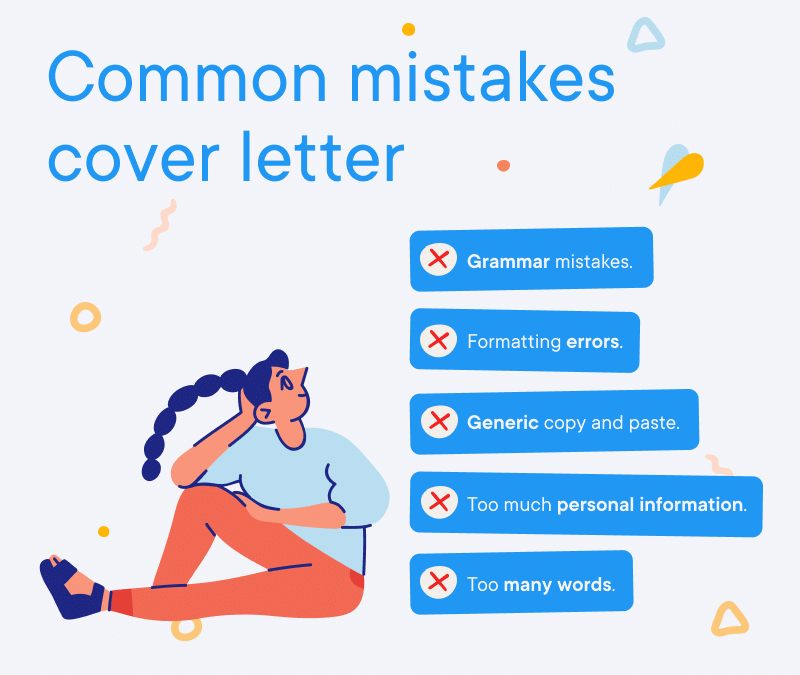
There are some classic cover letter mistakes that are easy to make, but also easy to avoid if you have this checklist in hand. Here are the ones you want to avoid:
- Spelling and grammar mistakes. Edit and proofread your cover letter with care. Typos, grammatical, and spelling mistakes are some of the main reasons recruiters reject job application documents, including cover letters. Software such as Grammarly is also a great tool to use in conjunction with proofreading your letter.
- Formatting issues. Your cover letter format should convey professionalism all the way. Issues, such as the header and body being too close or inconsistencies in font size, can be very noticeable. To make your life easier and avoid formatting headaches, use our tried and tested cover letter templates.
- Generic cover letter. Remember to avoid generic cover letters since they are not as impactful as targeted versions. This is because many candidates tend to regurgitate the same content from their CV (which becomes repetitive) and/or talk about what they want from the job, which isn’t too appealing to a recruiter either.
- Too long. You should be focusing on writing a snappy cover letter that gets your point across quickly and efficiently, ideally no longer than 400 words. You won’t have a lot of time to catch the attention of a hiring manager, so remember to use words that are impactful and minimal. Cut out anything that isn’t necessary to you getting called for an interview.
- Too personal. Being over-personal in a cover letter can work against you. The hiring manager doesn’t need to know about your family or pets or hear about the challenges of finding a job. Stick to a formal yet friendly tone and content related to your professional skills, experience, achievements, and goals.
Cover letter writing checklist
Do you think you’ve got the cover letter down? We all miss certain details occasionally, so before you hit send, consider these key points:
- Capture attention from the start. Kick-off with an engaging opening line. A strong “hook” can spark the hiring manager’s interest and encourage them to read on.
- Use action verbs. The language you choose makes a difference. Throughout your cover letter, opt for vibrant and assertive words as well as targeted keywords to increase your chances of job search success.
- Customise for the specific position. Always tailor your cover letter to fit the role and the company. Do your homework—explore the organisation’s website and social media platforms to learn more about the company's mission, vision, and values.
- Back up your claims with evidence. Always provide evidence to back up your statements. Whenever you assert an achievement, include a specific result or statistic that highlights your impact.
- End on an optimistic note: As you conclude your letter, keep the energy high and remain positive. Include a Call to Action (CTA) to invite the reader to reach out.
Your cover letter might feel like a sidekick to your CV, but it’s actually an important application document in its own right. Sometimes even the deciding factor between two very closely matched job applicants. By ticking all the checklist boxes, you’ll ensure that your cover letter is pitch-perfect when it reaches the eyes of a recruiter.
Your cover letter will accompany your CV, so make sure you use a matching header/template and font so that the documents look uniform. If you send two completely different documents this will just look confusing and won’t project your professionalism.
Cover letter examples
Looking for some inspiration to get started on your cover letter? Check out our vast selection of field-tested cover letter examples to get started.
Here are some of our top picks:
Cover letter writing FAQs
Here are some frequently asked questions that crop up around cover letters
Do employers really care about cover letters?
The value of cover letters is hotly debated. Many blogs and sources say that cover letters are pretty outdated and that only a small handful of HR professionals still care about them. If this is the case, then why bother?
The answer is that hiring managers are not all the same - for each one that ignores cover letters there’s another that will read every word, and this will influence who they invite to an interview. Since you have no way of knowing which type of professional you’ll get, it’s better to be safe than sorry and create a strong cover letter every time
What are the three main things needed in a cover letter?
A cover letter should have a compelling introduction that hooks the reader, a sales pitch that shows why you’re the perfect person for the job, and a convincing conclusion that summarizes the value you can bring to the company and your strong interest in the role. Your conclusion should wrap up with a call to action to encourage the hiring manager to get in touch.
What’s the best layout for a cover letter?
Choosing a simple, clean, and well-structured template is best. Keep your cover letter to one page, three paragraphs, with a professional font (Arial, Calibri), great formatting, and a final check for any typos, spelling, or grammatical errors.
Should I include a cover letter if the job posting says it’s optional?
Even though you’ve been given the option not to send a cover letter, it’s a good idea to include one anyway. This shows that you’re willing to put in the time and effort to write a cover letter and should impress recruiters. The caveat to this is when the job advert expressly asks you not to include a cover letter.
How do I keep my cover letter short and sweet?
Succinct, direct, and impactful is the goal of your cover letter. Keep your introduction short and interesting, ideally no more than two or three sentences. Avoid “fluff” and using unnecessary statements as this can lead to confusion. Finally, if including an example to back up any skills and experience, stick to one notable achievement rather than listing several examples.















